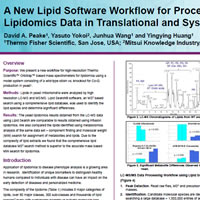Resumo do Pôster:
Application of lipidomics to disease phenotype analysis is a growing area in research. Identification of unique biomarkers to distinguish healthy humans compared to individuals with disease can have an impact on the early detection of diseases and personalized medicine. The complexity of the lipidome includes 8 major categories of lipids, over 80 major classes, 300 sub-classes and thousands of lipid species1 many with overlapping isomeric or isobaric molecular ions. Because of this complexity, molecular weight (MW) searches alone are not sufficient to identify lipids in a complex biological extract.
Identification of lipids requires sophisticated software with an extensive database. The combination of ultra-high resolution MS and MSn analysis should provide unambiguous and precise identification of lipids in biological samples. A robust algorithm for database searching of high-resolution data was developed by Professor Ryo Taguchi and co-workers2 and was commercialized by MKI (Tokyo, JP) as described recently3.
In this work we present a new workflow for high-resolution Thermo Scientific™ Orbitrap™-based mass spectrometers for lipidomics using a model system consisting of a wild-type strain vs. knockout for Co-Q production in yeast4.
Lipids in yeast mitochondria were analyzed by high resolution LC-MS and MS/MS. Lipid Search® software, an MS2 based search using a comprehensive lipid database, was used to identify the lipid species and determine significant differences.
The yeast lipidomics results obtained from the LC-MS data using Lipid Search are comparable to results obtained using infusion lipidomics. We also compared the lipids identified using metabolomics analysis of the same data set – component finding and MW search for assignment of metabolites and lipids. Due to the complexity of lipid extracts we found that the comprehensive lipid database MS2 search method is superior to the accurate mass based MW search for lipidomics.
References
- Fahy, E. et al. J. Lipid Res. 2009, 50, S9-S14. doi: 10.1194/jlr.R800095-JLR200
- Taguchi, R. et al. J. Chrom. A, 2010, 1217, 4229–4239. doi: 10.1016/j.chroma.2010.04.034
- Yamada, T. et al.J. Chrom. A, 2013, 1292, 211-218. doi: 10.1016/j.chroma.2013.01.078
- Peake, D. et al. Quantitative yeast lipidomics via LC-MS profiling using the Q Exactive Orbitrap mass spectrometer. Presented at the LIPID MAPS Annual Meeting, May 7-8, 2012, La Jolla, CA
|

